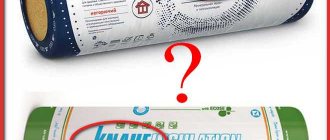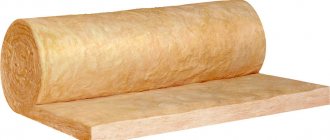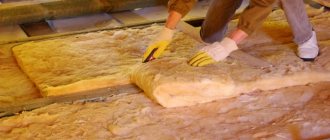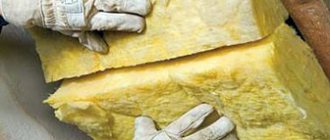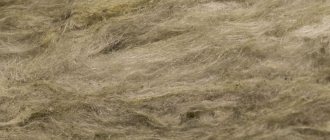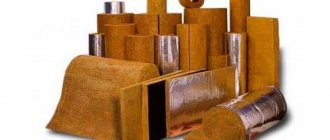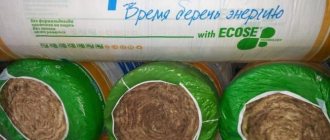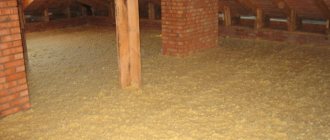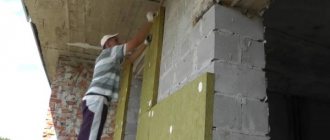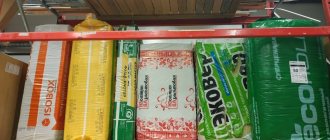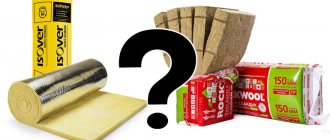Basalt wool is designed primarily to serve as insulation and retain heat in our homes in winter and keep cool in summer. The remarkable properties of the material allow it to be used on a large industrial scale, as well as in civil engineering. Basalt wool is widely used when carrying out work on thermal insulation of objects, and in addition serves as an excellent soundproofing tool.
Modern designers, when creating a new project, are very wary of new advertised building materials. This is due to past mistakes, when the construction complex sought to produce square meters in accordance with the tasks of the planned economy, without caring at all about the materials used, and without thinking about their impact on humans.
Recently, doctors have been sounding the alarm, expressing the opinion that the use of low-quality materials in the housing complex leads to asthma or, even worse, causes cancer problems. Particularly sensitive is the issue of using various heat-insulating materials; as a rule, they are covered with building structures and can affect us completely unnoticed.
Is basalt wool harmful to health?
Gaining enormous popularity as a heat and sound insulating material, we increasingly argue: is basalt wool harmful to human health or is its use absolutely harmless? The question is not an idle one, and our review is intended to understand how realistically the use of such material can be dangerous to human health.
City residents are increasingly thinking about the environmental safety of our living environment. Outside the windows of our homes, dozens of factories produce products, burning tons of gas and oil products, polluting the atmosphere with harmful substances. What can we say about the endlessly growing fleet of cars that undergo annual maintenance, but strangely leave behind clouds of black smoke exceeding all imaginable CO2 standards.
Nevertheless, all these harmful exhausts are carried somewhere into the distance by the wind, CO2 evaporates into the vast atmosphere and generally happens somewhere in the city with them, and not with us - our brain is lulled into a stream of consciousness. We worry much more about ourselves and our loved ones, we monitor proper nutrition, counting the numbers of preservatives on jars.
We are concerned about what the tiles, wallpaper, floors, and furniture in our home are made of. When planning the construction of a cottage or intending to carry out a long-planned renovation, we are increasingly taking a more responsible approach to the choice of noise and heat insulation materials. Understanding that we will have to live and come into contact with these substances for many years. For example, everyone knows that careless handling of glass wool leads to serious consequences, ranging from discomfort from needles to allergic reactions.
Here it’s probably worth taking a break and saying a few words about what this prickly material, familiar from childhood, is like.
Mineral wool: how dangerous is this insulation to health?
According to a number of experts, one of the most harmful building materials is mineral wool. Mineral wool is used for heat and sound insulation of residential premises everywhere. Some experts believe that the components included in its composition - mineral fibers, resins that bind them, which reduce the moisture absorption of the impregnation - cause serious diseases of the respiratory tract, eyes, and skin in people. The Association of Russian Thermal Insulation Manufacturers insists on the safety of its products. Builders, however, continue to use this thermal insulation material, which causes so much controversy. And officials don’t even try to figure out whether residents of mineral wool houses are endangering their health.
Today, the main share of the domestic market of thermal insulation materials is occupied by mineral wool producers. Mineral wool, especially slabs and sandwich panels based on it, are quite popular insulation in Russia. Where to buy mineral wool? Anywhere. Mineral wool is sold on any construction market, including on specialized websites on the Internet. Mineral wool is used for insulating pipes, utility rooms or houses from almost all sides: for insulating the walls of a house (outside and inside), facades, ceilings, attics, attics, loggias, as well as for sound insulation and noise insulation.
At the moment, you can buy mineral wool from various manufacturers on the Russian market. There are many of them, including Russian and Ukrainian factories; mineral wool production is established in Zheleznodorozhny, Kstovo, Kharkov and other cities. There are different types of mineral wool: foil, that is, with foil, acoustic mineral wool, in addition, various products made from it - pierced mats, thermal insulation cords, sandwich panels, slabs, cylinders, it is also sold in rolls (rolled), etc. Mineral wool is produced in different sizes and densities.
However, many foreign and Russian construction companies refuse to insulate their facilities with mineral wool. Firstly, due to the widespread and cheaper prices of competing insulation materials (silicate fiber, expanded polystyrene foam, polyurethane foam, polyethylene foam, etc., as well as insulation based on plant raw materials), and secondly, because of the harm, in their opinion damage caused by mineral wool to the environment and human health.
Is mineral wool the scent of death?
People began to argue and write about the dangers to human health and the environment from mineral wool relatively recently. Previously, it was believed that mineral wool as insulation was completely safe, environmentally friendly and non-flammable. And these qualities compensated for the fact that the price of mineral wool is higher than that of some other thermal insulation materials. But now a number of ecologists, doctors, and builders have begun to argue that the safety of mineral wool is, to put it mildly, exaggerated. In their opinion, the fibers contain carcinogenic components, and the binding material is phenol-formaldehyde or melamine-formaldehyde resin, which releases free formaldehyde, as well as phenol - highly toxic substances, in fact, are poisons for the human body.
Glass wool or basalt wool, which is better?
Glass wool is a fibrous mineral material. Nothing more than one of the types of mineral wool. In the production of glass wool, raw materials are used that are exactly the same as those that serve as a component of ordinary glass. Often recycled, collected material or waste from the glass industry is used. But wait, if this is a mineral material, then where is the danger, please explain to me, glass wool or basalt wool, which is better?
We know of three modifications of fibrous heat insulators made from mineral components:
- glass wool;
- basalt wool;
- slag.
If everything is clear with the first, there are no problems with the third either, it is made from molten blast furnace slag, and in fairness, we note that it is rarely found on construction markets, then I think it’s time to find out what the second is made of.
Basalt wool or mineral wool, which is better?
Basalt wool is an artificially produced, inorganic material. It is made by melting natural minerals and further forming them into a fibrous structure. Natural mineral - volcanic stone of basalt rock. That is why we can often hear the definition of mineral stone wool . Accordingly, the question of basalt wool or mineral wool, which is better, after finding out that they are the same thing, disappears by itself.
What is the safest insulation
Ursa PureOne - formaldehyde-free, acrylic based.
There is no point in determining which insulation is safe for health among natural materials, so only modern insulation of artificial origin should be considered. The most used thermal insulation materials:
- mineral wool;
- Styrofoam;
- polyurethane foam.
Typically, the manufacturers of each of the materials presented above claim that their insulation is safe for health. In fact, this is true, and disputes regarding the safety of a particular material revolve mainly around the components from which the insulation is made. It is also important how the insulation behaves under different operating conditions. For example, polystyrene foam is harmful as insulation if it is heated. During the process of melting or burning, it emits toxic gases, just like polyurethane foam. PPU is nothing more than a modified polystyrene foam, its improved descendant, so to speak.
If we consider the components of which insulation are absolutely safe for health, then you cannot find better mineral wool from Ursa from the PureOne line:
- made from quartz sand;
- does not contain formaldehyde - acrylic-based binder;
- soft fibers that do not break or create dust;
- does not irritate the skin - the color and texture is similar to cotton.
In addition, this material does not burn and can withstand temperatures above 800 degrees, which significantly expands the scope of its application.
Basalt wool - how do they do it?
The technology for making fiber from stone is “borrowed” from Mother Nature. One day, on the Hawaiian Islands, researchers found strange fibers, which later became known as “Pele’s Hair.” In honor of the beautiful girl Pele, the goddess of fire among the ancient settlers. Fibrous materials were produced as a result of volcanic eruptions. The formations resembled cotton wool made from thin threads of volcanic rocks. It was they who became the “progenitors” of modern heat-insulating material.
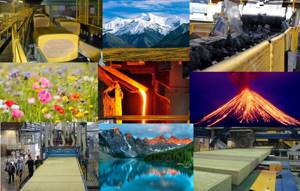
For the first time, such a substance was prepared artificially from rocks in 1897. in the United States of America. The production of basalt wool is not far removed from the natural work of the volcano, and to this day is based on the same principle. The rock is heated in furnaces to 1500 °C. As a result, a fiery liquid molten substance is formed, from which the threads that serve as the basis of fibrous wool are drawn.
Okay, we figured it out, all materials are mineral, although they are obtained artificially. What is the difference between glass wool and stone wool? Does using these materials mean we are at risk? Or are there differences? And the most incomprehensible thing is, if the material is mineral, then why is basalt wool harmful to health? What is this, speculation or rumors?
We found out that igneous rocks serve as raw materials. By the way, both dormant and active volcanoes can boast large deposits of basalt. Foreign - Etna and Vesuvius. In Russia - the Kamchatka and Kuril Mountains. These minerals and their derivatives, cotton wool, are truly harmless. But formaldehyde resin is used to bind the fibers together. It is this that contains phenols.
How to choose mineral wool
Mineral wool is a fibrous building material that is used for heat, sound, steam and fire retardant insulation of premises, utilities, and industrial equipment.
At the same time, mineral wool is characterized by low cost. Disadvantage: toxicity (releases phenol and formaldehyde). Important: the degree of danger of mineral wool is an open question. To minimize possible harm to health, purchase materials from well-known brands that value their reputation. Mineral wool must have documents certifying quality and safety (certificate of conformity, SES conclusion).
- Stone wool
- Glass wool
- Slag
Glass wool - made from waste glass, various minerals (limestone, dolomite, sand, borax, soda). Advantages: relatively low price and weight, high bending strength, good elasticity and vapor permeability, no dust during installation. Disadvantages: susceptible to shrinkage when moistened, particles cause irritation to the skin and upper respiratory tract.
Scope of application - mainly interior finishing work (insulation of attics and walls indoors). Also suitable for external insulation.
Stone / basalt – made from rocks of the basalt group. Advantages: resistance to deformation and shrinkage when moistened, high compressive strength, durability, easier installation. Disadvantages: relatively high cost and weight, low elasticity and vapor permeability, dust generation during installation.
Basalt wool differs from stone wool in its higher heat resistance. This insulating material, along with basalt fiber, contains clay, dolomite, limestone, mixture, and blast furnace slag.
Scope of application - mainly external finishing work (insulation of building facades, roof slopes, walls of baths and saunas, garages). Sometimes used indoors.
Important: although stone wool does not chip, when working with it you must use the personal protective equipment required for glass wool - goggles, a respirator, rubber gloves, closed overalls.
Slag wool – made from blast furnace slag (metallurgical waste). The only advantage is the low price. In terms of thermal insulation, chemical resistance, water and sound absorption it is inferior to other types of mineral wool. Practically not used.
Technical – used for insulation of pipelines, chimneys, ventilation pipes, baths and saunas. This material can withstand temperatures from -180°C to +700°C. Execution – slabs or rolls with foil coating.
Lightweight - used for insulating frame structures, withstands only light loads. Density varies between 10-90 kg/m3. Execution – slabs or rolls.
Rigid - designed to isolate the contours of structures, withstands high loads. Density is 90 kg/m3 or more. Execution: slabs.
Basalt wool phenol formaldehyde
Phenol production in the world amounts to more than 10 million tons/year. Phenol is considered one of the strongest industrial pollutants. Phenol is a toxic substance dangerous to animals and humans. Phenol is very difficult to undergo even biological purification. With all this, it serves as an indispensable component in the production of phenol-formaldehyde and epoxy resins, widely used in construction and everyday life.
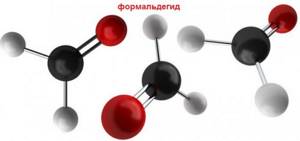
It is phenol, being exposed to the destructive effects of drafts, precipitation moisture and temperature changes, that negatively affects the physical condition of a person. Of course, the fibrous structure also makes its contribution: when exposed to certain factors, cotton wool contributes to the formation of fine and sharp dust, which in turn negatively affects our lungs and mucous organs during breathing.
What is stone wool made from?
Stone wool is produced from rocks, usually the basalt group, by melting at temperatures above 1500 degrees and then spraying onto the fibers under the influence of a powerful air flow. During the production process, special water-repellent and binders are added. After this, the material is pressed into a dense carpet so that the mineral wool acquires the required density.
Synthetic substances are used as binding components. As a rule, these are phenol alcohols, phenol-formaldehyde, and urea resins. Bitumen and bentonite clays are also used. Currently, a composite synthetic binder consisting of phenol-formaldehyde resins and water-repellent additives is most often used. It provides the best thermal insulation performance.
The final stage of production is cutting basalt wool into slabs and mats of the required sizes; molded products (cylinders, segments) can also be produced.

The best basalt wool
Now that we have identified the main “enemy,” everything falls into place. It turns out that the matter is not in the material, but in the absolutely precise ratio of components and following the established technological process. And the question of what is the best basalt wool can be answered with confidence - the one that was produced in compliance with the technological chain and complies with quality certificates.
In this case, the main rule for purchasing material is to carefully check the origin of the product. Any product has maximum permissible standards for the content of harmful substances, so do not be afraid to use basalt wool where they are not exceeded. The main well-known manufacturers today:
- Rockwool (Rockwool Scandic thickness 50mm, Rockwool Light Butts thickness 50mm), light butts 1000x600x50 mm
- TechnoNIKOL Rocklight thickness 50mm, Technolight extra 1200x600x100 mm
- Paroc thickness 50mm
- Isover thickness 50mm
- Knauf thickness 50mm
- Ursa thickness 50mm
- IZOVOL thickness 50mm
- Beltep thickness 50mm
- BASWOOL thickness 50mm
Technology for the production of basalt insulation
What it is
Let's start with something simple: what is basalt insulation from a technology point of view? The closest analogy is cotton candy . Anyone who knows how to make it will understand. For those who don't know, read on
